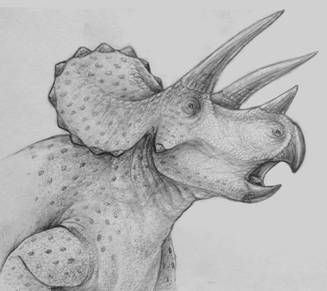Triceratops Dig Week 1
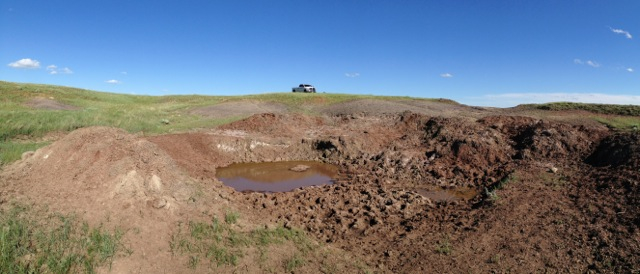
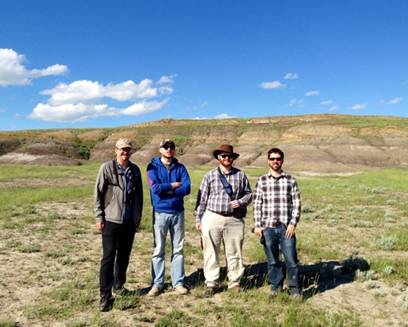
For the past week, a small crew from the Royal Ontario Museum’s palaeontology division (@ROMPalaeo) has been excavating a Triceratops site on private ranchland in Harding County, South Dakota (Fig. 1). The rocks exposed on the ranch are 67 million years old, and are classified as part of the famous Hell Creek Formation. This series of rocks preserves the very last chapter in the Age of Dinosaurs, and has produced many popularly well-known dinosaurs, including the armoured Ankylosaurus, the three-horned Triceratops, and the largest meat-eating animal to live on land- Tyrannosaurus rex. The ROM plans on working a Triceratops dominated bone bed that is already known on the ranch. These typically preserve hundreds of fossil bones from numerous individuals, jumbled together. They also tend to preserve the remains of many different species, which lived together at the same time and in the same general environment. We will also prospect the ranch for new fossil localities. It is hoped that the fossils that are collected with contribute to the PhD thesis of several graduate students studying at the University of Toronto and the ROM. It will also add more information to our knowledge of dinosaur fossil sites immediately preceding the mass extinction event at the end of the Cretaceous. This work has been facilitated by the generosity of a private collector and a ranching family in South Dakota, with the expedition itself being funded by the Freeman family of Toronto.
The 5-person team is being led my myself and Dr. Kevin Seymour from the ROM, with the assistance of Derek Larson and Mateusz Wosik (PhD students at the University of Toronto) and paleoartist Danielle Dufault. We decided to drive a large pick-up truck from Toronto to South Dakota in order to transport supplies there, and fossils back to the ROM. We left on Friday, June 13. After two and a half days for driving, the team finally arrived at the field area. We saw the site for the first time last Sunday afternoon.
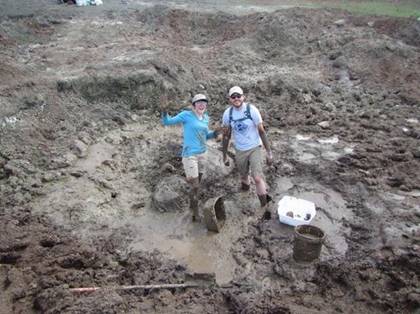
The main Triceratops site we are working has a relatively small amount of overburden (unfossiliferous rock on top of the fossil bone bearing layer) and is in a soft mud-rock that should be easy to work. But it wasn’t easy to get started- the quarry was completely underwater when we arrived! It turns out that it has been an usually rainy Spring in this part of the US. So our first order of business was to bail out the quarry and get it dry so that we can work.
We were just about done, and another torrential downpour hit on Tuesday, complete with tornado warnings and floods. After another 5 inches of rain, we had to start the bailing process all over (Fig. 2). This time we had the help of our rancher host and his tractor, and we were able to dig a proper drainage trench and get back on track.
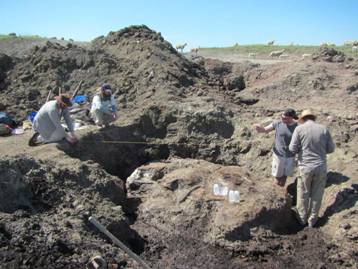 By Friday, we were exposing bones in the quarry. The first thing that we do is set up a grid system in order to map the fossils before we remove them from the rock (Figure 3). This provides information on how the bones came to be deposited at this particular spot. There is relatively little information on preservational processes in Hell Creek Formation. We will collect detailed provenance (taphonomic data) from excavated fossil sites, and hope to write a research paper on how the bones in the site came to be deposited and preserved.
By Friday, we were exposing bones in the quarry. The first thing that we do is set up a grid system in order to map the fossils before we remove them from the rock (Figure 3). This provides information on how the bones came to be deposited at this particular spot. There is relatively little information on preservational processes in Hell Creek Formation. We will collect detailed provenance (taphonomic data) from excavated fossil sites, and hope to write a research paper on how the bones in the site came to be deposited and preserved.
With the grid system set up, we are now ready to start exposing Triceratops bones. We have just over a week to uncover, map, and collect as many bones as we can. Stay tuned for more from the quarry.
Follow the Dig!
We have been continuously providing dig updates on Twitter via @ROMPalaeo using the hashtag #ROMTriceratops.
Read more in the news:
"ROM paleontology crew starts triceratops dig in South Dakota." City News.

